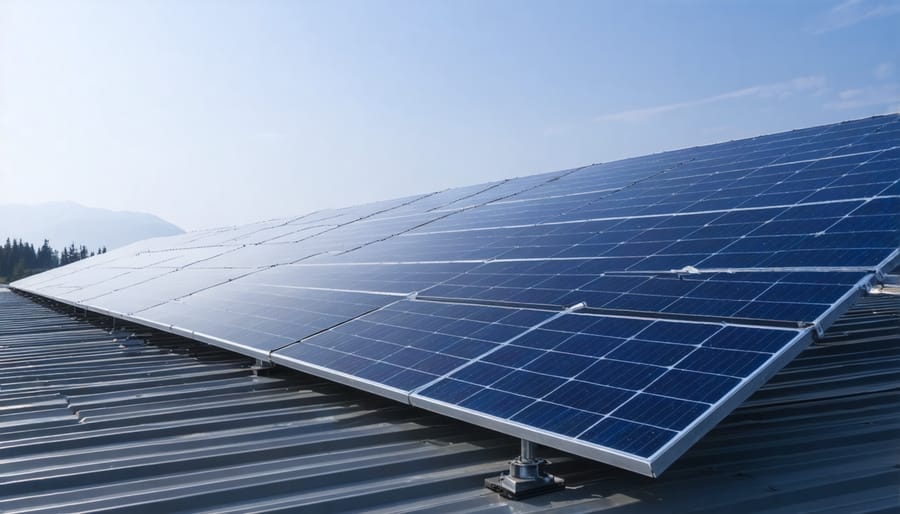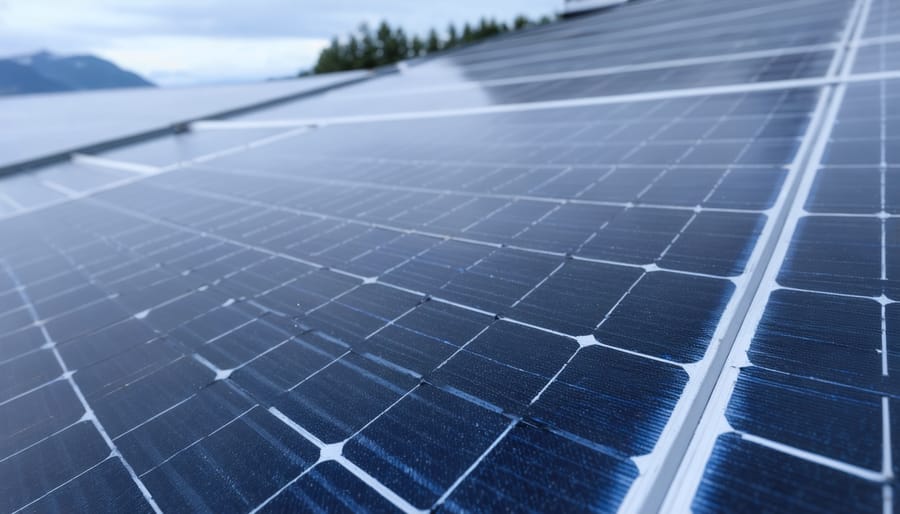N-type solar panels represent a groundbreaking advancement in photovoltaic technology, offering superior performance and efficiency compared to traditional p-type panels. These innovative panels use phosphorus-doped silicon as their base material, resulting in higher electron mobility and better performance in low-light conditions – a crucial advantage for British Columbia’s varied weather patterns. With efficiency rates reaching up to 25% and remarkable temperature coefficient ratings, n-type panels maintain strong power output even during hot summer days in the Okanagan or cool coastal conditions in Vancouver.
Unlike conventional solar technology, n-type panels resist light-induced degradation (LID), ensuring consistent energy production throughout their 25+ year lifespan. This durability, combined with their enhanced bifacial capabilities, makes them particularly valuable for BC homeowners and businesses looking to maximize solar energy production in our unique northern latitude. As communities across the province transition to renewable energy, n-type solar panels emerge as a premium choice for those seeking optimal performance and long-term reliability in their solar investments.
How N-Type Solar Panels Work
The Science Behind N-Type Silicon
Think of n-type silicon as a specially enhanced version of regular silicon, much like fortifying milk with vitamin D. In this process, manufacturers add small amounts of elements like phosphorus to pure silicon, creating a material that’s better at conducting electricity. This enhancement directly impacts solar panel efficiency by creating more pathways for electricity to flow.
When sunlight hits these n-type panels, it energizes electrons, making them move more freely through the material. Imagine a busy highway with well-maintained lanes – that’s how electrons travel through n-type silicon. This improved electron movement means more sunlight gets converted into usable electricity.
What makes n-type silicon special is its resistance to common problems that affect solar panels. Unlike its counterpart (p-type silicon), n-type silicon is less susceptible to performance degradation from light exposure and temperature changes – particularly important for British Columbia’s variable climate conditions. This stability means your solar panels maintain their performance longer, even after years of exposure to the elements.
Key Components and Structure
N-type solar panels are built with a specialized layered structure that sets them apart from traditional p-type panels. At their core, these panels use phosphorus-doped silicon wafers, which create a negative charge carrier base. This foundation is then combined with a boron-doped layer to form the panel’s unique architecture.
The key materials include high-purity silicon, phosphorus for the n-type doping, boron for creating the p-n junction, and silver paste for the electrical contacts. The panels also feature an anti-reflective coating that maximizes sunlight absorption, particularly beneficial during British Columbia’s varying weather conditions.
What makes these panels special is their multi-layer construction: a tempered glass cover protects the cells, while specialized encapsulation materials shield the internal components from moisture and environmental stress. The backing material, typically a durable polymer, completes the weatherproof structure.
For BC homeowners, these panels are particularly well-suited to our climate, as their construction helps them maintain high performance even during our cloudy coastal days and chilly mountain winters.

Advantages for BC Solar Users
Superior Low-Light Performance
In British Columbia’s often overcast climate, the superior performance during cloudy days makes n-type solar panels an especially smart choice for homeowners. Unlike traditional p-type panels, n-type technology maintains higher efficiency levels even in low-light conditions, making them particularly effective during our region’s characteristic gray days and shorter winter months.
Real-world testing in Vancouver and Victoria has shown that n-type panels can generate up to 10-15% more energy during overcast conditions compared to conventional panels. This advantage becomes especially significant when you consider that BC experiences an average of 160 cloudy days per year.
The enhanced low-light performance comes from n-type panels’ unique cell structure, which responds more effectively to indirect sunlight and diffused light conditions. This means your solar system continues producing substantial power even when the sun isn’t directly visible.
Local installers report that households using n-type panels maintain more consistent energy production throughout the year, with less dramatic seasonal fluctuations. For example, a North Vancouver family using n-type panels reported only a 25% decrease in winter energy production compared to summer, while conventional panels typically show a 35-40% reduction.
This improved performance during darker months helps ensure a more reliable year-round power supply, making n-type panels an excellent investment for BC residents committed to sustainable energy solutions.

Temperature Tolerance
In British Columbia’s diverse climate zones, temperature fluctuations can significantly impact solar panel performance. This is where n-type solar panels truly shine, offering superior temperature tolerance compared to traditional p-type panels. During hot summer days in the Okanagan or cold winter months along the coast, n-type panels maintain their efficiency more consistently.
N-type panels typically experience a lower power loss rate as temperatures rise, losing only about 0.3% efficiency per degree Celsius compared to 0.4-0.5% in conventional panels. This advantage becomes particularly valuable in areas like Kelowna or Kamloops, where summer temperatures regularly exceed 30°C.
Even more impressive is their cold-weather performance. While all solar panels actually become more efficient in colder temperatures, n-type panels maintain higher voltage output during winter months. This characteristic is especially beneficial in northern BC communities and mountainous regions where winter temperatures can drop well below freezing.
Local installations have shown that n-type panels can produce up to 3-5% more energy annually compared to traditional panels, simply due to better temperature handling. For example, a residential installation in Vernon maintained 92% of its rated efficiency during last summer’s heat wave, while comparable p-type systems dropped to 88% efficiency.
This enhanced temperature tolerance means more consistent power generation throughout BC’s seasonal temperature swings, ultimately leading to more reliable energy production and better long-term value for homeowners and businesses.
Cost vs. Performance Analysis
Initial Investment Considerations
While n-type solar panels typically have higher upfront installation costs compared to traditional p-type panels, BC residents can benefit from several financial incentives that help offset this investment. The CleanBC Better Homes Program offers rebates of up to $1,000 per kilowatt of installed capacity, with a maximum of $8,000 for residential installations. Business owners can access additional incentives through the BC Hydro Business Energy Saving Incentives (BESI) program.
When considering n-type panels, factor in their superior longevity and higher efficiency, which typically result in better long-term returns. Local homeowners report breaking even on their n-type solar investments within 8-10 years, compared to 10-12 years for conventional panels. This calculation factors in BC’s electricity rates, which have risen by an average of 3% annually over the past decade.
Many local credit unions offer green energy loans with competitive interest rates, making the initial investment more manageable. Some municipalities in BC also provide property tax exemptions for solar installations, further improving the financial outlook for n-type solar adoption.
Long-Term Value and ROI
When evaluating the long-term benefits of n-type solar panels, homeowners in British Columbia can expect exceptional returns on their investment. These panels typically maintain over 90% of their original efficiency even after 25 years, compared to 80-85% for traditional p-type panels. This superior performance translates into consistent energy production and greater savings over time.
For a typical BC home with a 6kW n-type solar system, owners can expect to save between $800-1,200 annually on electricity bills, depending on their location and energy consumption patterns. While the initial cost may be 10-15% higher than conventional panels, the increased energy yield and longer lifespan often result in a break-even point within 6-8 years.
The panels’ enhanced durability and resistance to light-induced degradation mean fewer replacement needs and maintenance costs. In BC’s varied climate conditions, from sunny Okanagan summers to cloudy coastal winters, n-type panels maintain their efficiency more consistently than traditional alternatives.
Many local installers now offer performance warranties extending to 30 years, reflecting their confidence in n-type technology’s longevity. When combined with available rebates and incentives, these panels represent a sound investment in both environmental sustainability and long-term financial returns.

Installation and Maintenance Tips
Installing n-type solar panels in BC requires careful planning and attention to detail for optimal performance. Start by ensuring your roof can support the panels’ weight and is oriented to maximize sunlight exposure, ideally facing south with a 30-45 degree tilt. While professional installation is recommended, knowing these basics helps you make informed decisions.
For maintenance, BC’s climate presents unique challenges. Regular cleaning is essential, especially during spring pollen season and after fall leaf drop. Use soft brushes and mild soap solutions, avoiding harsh chemicals that might damage the panel surface. In winter, snow typically slides off n-type panels due to their smooth surface, but occasional gentle removal may be necessary using a soft-bristled roof rake.
Monitor your system’s performance through its inverter display or monitoring app. A sudden drop in energy production could indicate maintenance needs. Schedule professional inspections annually, preferably in early spring before peak production season. These check-ups should include electrical connections, mounting hardware, and overall panel condition.
To protect your investment, trim overhanging branches that could shade panels or cause debris accumulation. Keep gutters clean to prevent water backup around panel mounts. Consider installing critter guards if local wildlife is active near your roof.
Remember that n-type panels generally require less maintenance than p-type alternatives, but regular care ensures maximum efficiency and longevity in BC’s varied climate conditions.
N-type solar panels represent a significant advancement in solar technology, offering higher efficiency and better performance in British Columbia’s diverse climate conditions. As we’ve explored, these panels excel in low-light conditions and demonstrate superior temperature tolerance, making them an excellent choice for our region’s varying weather patterns.
For homeowners and businesses interested in making the switch to n-type solar panels, we encourage you to connect with local certified installers who can provide personalized assessments of your property’s solar potential. Take advantage of BC’s solar incentive programs and use our interactive solar savings calculator to estimate your potential return on investment.
Join the growing community of British Columbians embracing sustainable energy solutions. Whether you’re ready to install or still exploring your options, our team is here to help you navigate your solar journey and make informed decisions that benefit both your bottom line and our environment.

